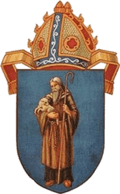Anglican Diocese of Brisbane facts for kids
Quick facts for kids Diocese of Brisbane |
|
|---|---|

Coat of arms
|
|
| Location | |
| Country | Australia |
| Territory |
|
| Ecclesiastical province | Queensland |
| Metropolitan | Archbishop of Brisbane |
| Headquarters |
|
| Information | |
| Denomination | Anglican |
| Rite | |
| Established | 1858 |
| Cathedral | St John's Cathedral, Brisbane |
| Language | English |
| Current leadership | |
| Parent church | Anglican Church of Australia |
| Archbishop | Phillip Aspinall (since February 2002) |
| Dean |
|
The Anglican Diocese of Brisbane, also known as Anglican Church Southern Queensland, is based in Brisbane, Queensland, Australia. The diocesan bishop's seat is at St John's Cathedral, Brisbane. The diocese stretches from the south-eastern coastline of Queensland, down to the New South Wales border and west to the Northern Territory and South Australian borders. The diocese currently markets itself as "Anglican Church Southern Queensland" (ACSQ). The "Anglicare Southern Queensland" brand is also heavily promoted by the diocese.
The current Archbishop of Brisbane is Phillip Aspinall, who was formerly the primate of the Anglican Church of Australia. The current assistant bishops are Cameron Venables (Bishop of the Western Region since 2014), Jeremy Greaves (Northern Region since 2017) and John Roundhill (Southern Region since 2018).
Contents
History
Queen Victoria created the Anglican Diocese of Brisbane and in 1859 appointed Edward Tufnell (1814–1896) as the first diocesan bishop. Tufnell designated St John's Cathedral in Brisbane as the pro-cathedral. The central stained glass windows in the apse, the crucifixion, at St Mary's Church, was donated by Bishop Tufnell.
The second bishop was Matthew Hale, who was translated from Perth in 1876. Hale was succeeded by William Webber, who was the last man to be only Bishop of Brisbane (from 1885 to 1904) as the new ecclesiastical province of Brisbane would in future be headed by an archbishop as the incumbent.
A see house called Bishopsbourne (now Old Bishopsbourne) was built in Milton c. 1865 for Edward Tufnell. It was used by subsequent bishops and archbishops until Archbishop Philip Strong purchased the house Eldernell (formerly Farsley) at 39 Eldernell Street, Hamilton in 1964, renaming it Bishopsbourne. In April 2007, Archbishop Phillip Aspinall sold the Hamilton residence for $11.2 million and moved to a residence in Ascot costing $2.6 million, which has also been renamed Bishopsbourne.
Culture
The Diocese of Brisbane has a predominantly moderate Anglo-Catholic culture. Groups such as the Society of Saint Francis and the Oratory of the Good Shepherd have their Australian base in the City of Brisbane and the Society of the Sacred Advent first emerged in the city. This latter group is responsible for running St Margaret's Anglican Girls' School.
Saint Francis' Theological College, at which most of the diocese's priests are trained, has historically "combined a Catholic interpretation of the Book of Common Prayer with an acceptance of ‘moderate’ biblical criticism. This... [is]... the liberal Catholicism of Bishop Gore and Lux Mundi".
Archbishop Phillip Aspinall is, himself, a liberal Anglo-Catholic and gave the keynote address at the Australian Church Union's 2006 Keble Mass. Consistent with this more liberal tendency, the Social Responsibilities Committee of the diocese has endorsed same-sex civil unions.
For the most part the diocese's parishes exhibit the "rather self-conscious Anglo-Catholic congregationalism of the capital cities, often tinged with radical Socialism". Parishes that reflect this outlook include Holy Trinity Fortitude Valley, with its emphasis on social justice, and Kilcoy-Woodford with its focus on Christian pacifism.
The Angligreen environmental group has also emerged as a significant voice in the diocese.
By contrast, All Saints' Brisbane is notable for having links to the conservative Forward in Faith organisation which maintains a small presence in the city. Of All Saints' Masses, journalist Keith Dunstan noted "‘the whole sense of theatre’. Others, drawing on a religious vocabulary, compared the experience to ‘being in heaven’." However, All Saints is an exception to the more moderate approach as "'extreme’ Anglo-Catholicism [never took hold in Brisbane and] has flourished only among clergy in the diocese of Ballarat."
Despite this dominant Anglo-Catholic ethos, there is a low church Bible belt running through a few of the City of Brisbane's southern suburbs. However, the last time there was any major controversy about the diocese's Anglo-Catholic outlook was in 1956.
Archishops of Brisbane
With the creation of the Province of Queensland in 1905, the Diocese of Brisbane became the permanent metropolitan see, and its bishop the metropolitan archbishop.
| Archbishops of Brisbane | |||
|---|---|---|---|
| From | Until | Incumbent | Notes |
| 1905 | 1921 | St Clair Donaldson | Translated to Salisbury. |
| 1921 | 1933 | Gerald Sharp | Died in office. |
| 1934 | 1943 | William Wand | Translated to Bath and Wells and later to London. |
| 1943 | 1962 | Reginald Halse | Translated from Riverina; knighted in 1962; died in office. |
| 1963 | 1970 | Philip Strong | Translated from New Guinea; Primate of Australia, 1966–1970. |
| 1970 | 1980 | Felix Arnott | Previously coadjutor bishop in Melbourne. |
| 1980 | 1989 | John Grindrod | Previously Bishop of Riverina and then of Rockhampton; Primate of Australia, 1982–1989; knighted in 1983. |
| 1990 | 2001 | Peter Hollingworth | Translated from the Inner City, Melbourne; Governor-General of Australia, 2001–2003. |
| 2002 | present | Phillip Aspinall | Previously assistant bishop in Adelaide; Primate of Australia, 2005-2014. |
Demography
According to a synod paper, between 2011 and 2016, the number of parishioners in the diocese declined by 7%.

